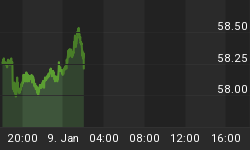We believe that the S&P 500 declining to the level of 500 is plausible before the current unpleasantness is over. That would put the index at the same approximate price as March 1995, before the internet bubble got well underway.

In a recent article, we made the case on the basis of earnings and normalized price-earnings ratios that the index could decline to between 600 and 400. The normalized P/E ratios used were taken from a long-term study we did of the S&P from 1936.
Ranges:
Most commentators refer to near-term upside targets in the vicinity of 950 to 1000 for the S&P 500, and to a clear bottom at about 750. That may well prove to be the case, but intellectual room should be made for a more severe correction before 'the" bottom, instead of 'a" bottom is reached at lower levels.

Dividend Perspective:
Before 1958, dividend yields were higher than bond yields, as investors recognized the inherently greater risk of stocks versus bonds. Perhaps recent stock problems will move investors back toward the pre-1958 perspective. That would put strong negative pressure on stocks.
Before Q4 2008, Obama campaigned on the theme of rolling back investment tax benefits passed during the Bush administration. Favorable taxation of dividends is prominent in those benefits. If the President and Congress follow-through on that and raise dividend taxes, that would put negative pressure on stock prices.
Banks, which recently accounted for 12+% of S&P 500 market-cap, generate more than 25% of total dividends for the index (proxy SPY). In addition to a general slowing of dividend increases across industries, the large banks that make up the bulk of the S&P financial sector (proxy XLF, and closely tracked by KBE) are dramatically reducing dividends. If the combination of business needs and TARP rules force virtually all large banks to reduce dividends to $0.01 per quarter, the S&P index would have to decline into the 600's to restore the current 3+% index dividend yield.
Graphical Chart View:
This chart shows the historically above average P/E and the historically below average dividend yield compared to periods back to 1926.

It is difficult for us to believe that above average P/E ratios can be maintained in a below average earnings environment. Surely, if earnings hit a soft spot, index prices might fall less, with consequent elevation of the P/E ratio, but we are in much worse than a soft spot, both in degree and duration. We expect that the P/E should at least be in the long-term mid-range before the decline is over.
Similarly, dividend yields are lower than historical levels. Admittedly, Treasury rates are very low, but that does not seem to be a long-term sustainable level. When Treasury rates rise, dividend yields should rise too, putting downward pressure on stocks.
Long-Term Growth Rate Perspective:
Using a semi-log (constant % change for Y-axis) chart of the index since 1950, drawing a line across tops and bottoms before the internet bubble, you see a price range with a top near where we are today, but with a bottom well below. That approach suggests a range of 800 to 400 for the index.

Using an arithmetic chart (unit price change for Y-axis) from 1927, superimposing different growth rate curves, a general range of 1200+ to 400- presents itself, if you assume an approximate 4% to 5.5% price return (before additional return from dividends). The current near 800 level for the index corresponds roughly with a 5% price (excluding dividends) return over the past 81 years.

Back to the Plausible 500 Target:
We used a semi-log chart from 1926 through today and out to the end of 2010 (based on projections by Standard & Poor's) in the following chart. Drawing lines across the tops and bottoms in the pre-internet bubble period, we see a top of range about where we are today, and a bottom of range that is at the level of about March 1995 (or about 500).

Summary:
The several approaches we have taken here, all produce a broad range of plausible downside price levels well below the 750 that has recently been heralded as "the" bottom by many commentators.
We recommend keeping powder dry until there is a clear pattern of upward price movement, and not just the index touching 800 or 750 as presumed bottoms. Consider the possibility of 600, 500 or even 400 if the world economy becomes as bad as the policy actions by governments suggest.
Whatever you decide to do, use persistent trailing stop losses on your positions, just in case the bottom falls out. It can happen. It has happened before, and it may happen again.
















